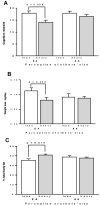Perception of others' body size influences weight loss and regain for European American but not African American women
- PMID: 19594265
- PMCID: PMC2711516
- DOI: 10.1037/a0014667
Perception of others' body size influences weight loss and regain for European American but not African American women
Abstract
Objective: The authors investigated whether European American (EA) and African American (AA) women took longer to lose weight, and were less likely to maintain weight loss if they perceived others to be overweight.
Design: Overweight EA and AA women completed a Figure Rating Scale and the Three-Factor Eating Questionnaire prior to a weight loss intervention. Body composition was assessed by dual energy X-ray absorptiometry prior to and following weight loss.
Main outcome measures: rate of weight loss, % body fat at follow-up.
Results: For EA, but not AA women, perception of others' body size was inversely associated with rate of weight loss and cognitive restraint, and positively associated with body fat gain following intervention. In linear regression modeling, EA, but not AA, women who perceived others as large, subsequently had greater percent body fat 1 year after weight loss than did those who perceived others as lean, independent of age, baseline body fat, and body size deemed "acceptable." Inclusion of cognitive restraint in the model weakened this effect.
Conclusion: Among EA but not AA women, perception of others' body size influenced weight loss and maintenance. This effect may have been mediated by cognitive restraint.
Figures

Similar articles
-
Associations among body size dissatisfaction, perceived dietary control, and diet history in African American and European American women.Eat Behav. 2009 Dec;10(4):202-8. doi: 10.1016/j.eatbeh.2009.06.003. Epub 2009 Jul 3. Eat Behav. 2009. PMID: 19778748 Free PMC article.
-
Racial Differences in Relative Skeletal Muscle Mass Loss During Diet-Induced Weight Loss in Women.Obesity (Silver Spring). 2018 Aug;26(8):1255-1260. doi: 10.1002/oby.22201. Epub 2018 Jun 29. Obesity (Silver Spring). 2018. PMID: 29957829 Free PMC article. Clinical Trial.
-
Attitudes toward body size and dieting: differences between elderly black and white women.Am J Public Health. 1994 Aug;84(8):1322-5. doi: 10.2105/ajph.84.8.1322. Am J Public Health. 1994. PMID: 8059896 Free PMC article.
-
Behaviors and characteristics of African American and European American females that impact weight management.J Nurs Scholarsh. 2011 Jun;43(2):133-44. doi: 10.1111/j.1547-5069.2011.01393.x. Epub 2011 Apr 6. J Nurs Scholarsh. 2011. PMID: 21605317 Clinical Trial.
-
Different shapes in different cultures: body dissatisfaction, overweight, and obesity in African-American and caucasian females.J Pediatr Adolesc Gynecol. 2003 Dec;16(6):349-54. doi: 10.1016/j.jpag.2003.09.007. J Pediatr Adolesc Gynecol. 2003. PMID: 14642955 Review.
Cited by
-
Weight Perceptions and Weight Loss Attempts: Military Service Matters.Mil Med. 2020 Mar 2;185(3-4):e397-e402. doi: 10.1093/milmed/usz413. Mil Med. 2020. PMID: 31822913 Free PMC article.
-
The Relationship between Social Network Body Size and the Body Size Norms of Black and Hispanic Adults.Prev Med Rep. 2015;2:941-945. doi: 10.1016/j.pmedr.2015.10.014. Prev Med Rep. 2015. PMID: 26705513 Free PMC article.
-
Social network body size is associated with body size norms of South Asian adults.Obes Med. 2018 Sep;11:25-30. doi: 10.1016/j.obmed.2018.06.001. Epub 2018 Jun 30. Obes Med. 2018. PMID: 31338475 Free PMC article.
-
Determinants of weight loss maintenance: a systematic review.Obes Rev. 2019 Feb;20(2):171-211. doi: 10.1111/obr.12772. Epub 2018 Oct 16. Obes Rev. 2019. PMID: 30324651 Free PMC article.
-
The role of social networks in the development of overweight and obesity among adults: a scoping review.BMC Public Health. 2015 Sep 30;15:996. doi: 10.1186/s12889-015-2314-0. BMC Public Health. 2015. PMID: 26423051 Free PMC article.
References
-
- Ard JD, Greene LC, Malpede CZ, Jefferson WK. Association between body image disparity and culturally specific factors that affect weight in Black and White women. Ethn Dis. 2007;17(suppl 2):34–39. - PubMed
-
- Ball K, Crawford D. An investigation of psychological, social and environmental correlates of obesity and weight gain in young women. Int J Obes (Lond) 2006;30(8):1240–1249. - PubMed
-
- Becker DM, Yanek LR, Koffman DM, Bronner YC. Body image preferences among urban African Americans and whites from low income communities. Ethn Dis. 1999;9(3):377–386. - PubMed
-
- Christakis NA, Fowler JH. The spread of obesity in a large social network over 32 years. N Engl J Med. 2007;357(4):370–379. - PubMed

